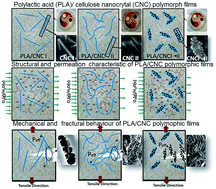Effect of cellulose nanocrystal polymorphs on mechanical, barrier and thermal properties of poly(lactic acid) based bionanocomposites†
Abstract
Cellulose nanocrystals (CNCs) using different polymorphs of cellulose were fabricated from raw bamboo pulp through alkali treatment followed by acid hydrolysis. The effect of CNC polymorphs, namely CNC I, CNC II and CNC:I → II (CNC II from cellulose I), on morphology, crystal structure, degree of hydrogen bonding and thermal stability were studied. These polymorphs were dispersed in polylactic acid (PLA) films using a casting evaporation approach and their effect on the structural, thermal, mechanical and barrier properties of the PLA were investigated. The CNC polymorphs differ significantly in their reinforcement capability and ability to form percolated networks. Incorporation of CNC II and CNC:I → II significantly improved the Young's modulus of composites (by ∼72%). However, their elongation at break significantly decreased compared to CNC I, due to high hydroxyl functionality, which forms an entangled hydrogen bonded network within the polymer matrix, leading to improvement in mechanical as well as barrier properties. The theoretically calculated moduli of composites using Halpin–Kardos, Cox–Krenchel and Ouali models showed good agreement for CNC I, CNC II and CNC:I → II, albeit at higher aspect ratio. All three CNCs showed the ability to form percolated networks, the occurrence and stability of which varied with the type of polymorph. Therefore, the current study provides an insight towards selection of appropriate polymorphs for fabrication of CNC reinforced high performance poly (lactic acid) based bionanocomposites.


 Please wait while we load your content...
Please wait while we load your content...